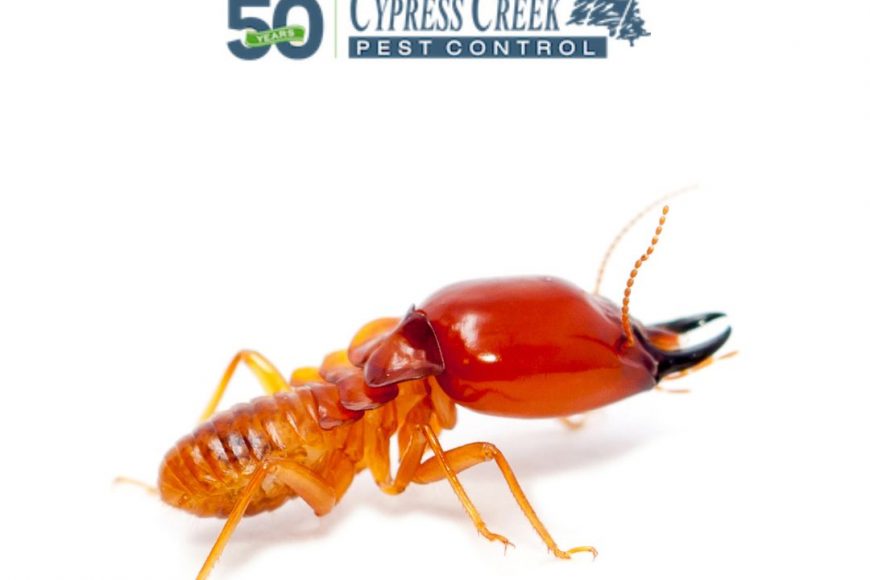Fill out the form below and a Cypress Creek representative will be in touch with you about your pest control needs.
BLOG

Termite Species in Houston: A Comprehensive Guide
If you live in Houston or plan to move there, you may want to know about the different termite species found in the area. Termites can cause significant damage to homes and businesses, and it’s essential to identify the type of termite infesting your property to determine the best course of action for treatment and prevention. In this article, we’ll cover the most common termite species found in Houston, their habits, and how to identify them.
What are termites?
Before we dive into the different species found in Houston, let’s briefly discuss what termites are. Termites are small, white or brown insects that feed on wood and other cellulose materials. They live in large colonies and can cause significant structural damage to homes and other buildings.
Subterranean Termites
Subterranean termites are the most common species found in Houston. They live in the soil and create mud tubes to travel to their food source. They feed on wood, paper, and other cellulose materials and can cause extensive damage if left untreated.
Eastern Subterranean Termites
Eastern subterranean termites are the most destructive species of termites in the United States. They can cause severe structural damage to homes and other buildings, and they are prevalent in Houston.
Formosan Subterranean Termites
Formosan subterranean termites are an invasive species that came to the United States after World War II. They are more aggressive than other species and can cause extensive damage in a short amount of time.
Drywood Termites
Drywood termites are another species found in Houston, but they are less common than subterranean termites. Unlike subterranean termites, drywood termites don’t need soil to survive. They live inside the wood they are feeding on, and their colonies are usually smaller than subterranean termite colonies.
Western Drywood Termites
Western drywood termites are the most common species of drywood termites found in the United States. They are usually found in coastal areas, including Houston.
Powderpost Drywood Termites
Powderpost drywood termites are a less common species of drywood termites found in Houston. They are smaller than other species and can cause significant damage if left untreated.
Dampwood Termites
Dampwood termites are the least common species found in Houston. They live in moist wood, and their colonies are usually smaller than subterranean termite colonies.
Southeastern Dampwood Termites
Southeastern dampwood termites are the most common species of dampwood termites found in the United States. They are usually found in coastal areas and can cause significant damage to homes and other buildings.
How to Identify Termite Infestations
Identifying a termite infestation can be challenging, but there are some signs to look out for. Some common signs of a termite infestation include:
- Mud tubes on the exterior of your home or building
- Wood that sounds hollow when tapped
- Cracked or bubbling paint
- Discarded wings near windows and doors
- Termite droppings, which look like small pellets
If you suspect a termite infestation, it’s essential to contact a professional pest control company as soon as possible. They can identify the type of termite infesting your property and recommend the best course of action for treatment and prevention.
How to Prevent Termite Infestations
Preventing a termite infestation is key to protecting your property from damage. Here are some tips for preventing termite infestations:
- Eliminate sources of moisture around your home or building
- Seal any cracks or gaps in the foundation or walls of your home or building
- Store firewood and other wood debris away from your home or building
- Keep gutters and downspouts clear of debris to prevent water buildup
- Avoid using wood mulch near your home or building
Treatment Options
If you have a termite infestation, there are several treatment options available. The best course of action depends on the type and severity of the infestation. Some common treatment options include:
- Chemical treatments: These involve applying pesticides or other chemicals to the affected area to kill the termites.
- Baiting systems: Baiting systems involve placing bait stations around the perimeter of your property to attract termites and then kill them.
- Fumigation: Fumigation involves sealing your home or building and then pumping in a gas to kill the termites.
It’s important to note that some treatments may require you to vacate your home or building for a period of time. A professional pest control company can help you determine the best treatment option for your situation.
Termites can cause significant damage to homes and other buildings in Houston, and it’s important to be able to identify the type of termite infesting your property. By taking preventative measures and contacting a professional pest control company if you suspect an infestation, you can protect your property and ensure its long-term structural integrity.
FAQs
- How do I know if I have a termite infestation?
- Look for signs such as mud tubes, hollow wood, cracked paint, discarded wings, or termite droppings.
- What should I do if I suspect a termite infestation?
- Contact a professional pest control company to identify the type of termite and recommend a treatment plan.
- Can I prevent termite infestations?
- Yes, by eliminating sources of moisture, sealing cracks and gaps, storing wood debris away from your home, and avoiding wood mulch.
- What treatment options are available for termite infestations?
- Chemical treatments, baiting systems, heat treatments, and fumigation are all common treatment options.
- Do I need to vacate my home during termite treatments?
- Some treatments may require you to vacate your home, so it’s important to discuss this with your pest control company.

